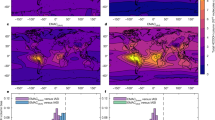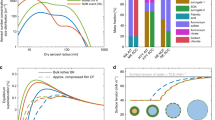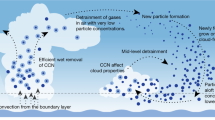Abstract
Clouds profoundly influence weather and climate1. The brightness2 and lifetime3,4 of clouds is determined by cloud droplet number concentration, in turn dictated by the number of available seed particles. The formation of cloud droplets on non-volatile atmospheric particles is well understood5. However, fine particulate matter in the atmosphere ranges widely in volatility6,7. Co-condensation of semi-volatile compounds with water increases a particle’s propensity for cloud droplet formation8, with potential consequences for feedbacks between the terrestrial biosphere and climate9. Here we systematically study cloud droplet formation, using a cloud parcel model extended to include co-condensation of semi-volatile organic compounds under a broad variety of realistic conditions. As an air parcel rises and cools, the concentration of organic vapour that it can hold declines. Thus, the simulated organic vapours become increasingly saturated as they ascend, and so condense on growing particles as they swell into cloud droplets. We show that condensation of increasingly volatile material adds to the soluble mass of these droplets and facilitates the uptake of additional water, which leads, in turn, to a substantial increase in the number of viable cloud droplets. We suggest that the co-condensation of semi-volatile organic compounds with water vapour has a substantial impact on the radiative properties of clouds.
This is a preview of subscription content, access via your institution
Access options
Subscribe to this journal
Receive 12 print issues and online access
$259.00 per year
only $21.58 per issue
Buy this article
- Purchase on Springer Link
- Instant access to full article PDF
Prices may be subject to local taxes which are calculated during checkout



Similar content being viewed by others
References
Denman, K. L. et al. in Climate Change 2007: The Physical Science Basis (eds Solomon, S. et al.) (Cambridge Univ. Press, 2007).
Twomey, S. The influence of pollution on the shortwave albedo of clouds. J. Atmos. Sci. 34, 1149–1152 (1977).
Albrecht, B. A. Aerosols, cloud microphysics and fractional cloudiness. Science 245, 1227–1230 (1989).
Stevens, B. & Feingold, G. Untangling aerosol effects on clouds and precipitation in a buffered system. Nature 461, 607–613 (2009).
McFiggans, G. et al. The effect of physical and chemical aerosol properties on warm cloud droplet activation. Atmos. Chem. Phys. 6, 2593–2649 (2006).
Jimenez, J. L. et al. Evolution of organic aerosols in the atmosphere. Science 326, 1525–1529 (2009).
Hallquist, M. et al. The formation, properties and impact of secondary organic aerosol: Current and emerging issues. Atmos. Chem. Phys. 9, 5155–5235 (2009).
Topping, D. & McFiggans, G. Tight coupling of particle size, number and composition in atmospheric cloud droplet activation. Atmos. Chem. Phys. 12, 3253–3260 (2012).
Kulmala, M. et al. A new feedback mechanism linking forests, aerosols, and climate. Atmos. Chem. Phys. 4, 557–562 (2004).
Feingold, G. Modeling of the first indirect effect: Analysis of measurement requirements. Geophys. Res. Lett. 30, 1997 (2003).
Dusek, et al. Size matters more than chemistry for cloud-nucleating ability of aerosol particles. Science 312, 1375–1378 (2006).
Köhler, H. The nucleus in and the growth of hygroscopic droplets. Trans. Farady Soc. 32, 1152–1161 (1936).
Cappa, C. D. & Jimenez, J. L. Quantitative estimates of the volatility of ambient organic aerosol. Atmos. Chem. Phys. 10, 5409–5424 (2010).
Conant, W. C. et al. Aerosol–cloud drop concentration closure in warm cumulus. J. Geophys. Res. 109, D13204 (2004).
Fountoukis, C. et al. Aerosol–cloud drop concentration closure for clouds sampled during the International Consortium for Atmospheric Research on Transport and Transformation 2004 campaign. J. Geophys. Res. 112, D10S30 (2007).
Kolb, C. E. et al. An overview of current issues in the uptake of atmospheric trace gases by aerosols and clouds. Atmos. Chem. Phys. 10, 10561–10605 (2010).
Riipinen, I. et al. The contribution of organics to atmospheric nanoparticle growth. Nature Geosci. 5, 453–458 (2012).
Schwartz, S. E. & Slingo, A. in Clouds, Chemistry, and Climate (eds Crutzen, P. & Ramanathan, V.) 191–236 (Springer, 1996).
Wang, J., Lee, Y-N., Daum, P. H., Jayne, J. & Alexander, M. L. Effects of aerosol organics on cloud condensation nucleus (CCN) concentration and first indirect aerosol effect. Atmos. Chem. Phys. 8, 6325–6339 (2008).
Kulmala, M. et al. The effect of atmospheric nitric-acid vapor on cloud condensation nucleus activation. J. Geophys. Res. 98, 22949–22958 (1993).
Laaksonen, A., Hienola, J., Kulmala, M. & Arnold, F. Super- cooled cirrus cloud formation modified by nitric acid pollution of the upper troposphere. Geophys. Res. Lett. 24, 3009–3012 (1997).
Hegg, D. A. Impact of gas-phase HNO3 and NH3 on microphysical processes in atmospheric clouds. Geophys. Res. Lett. 27, 2201–2204 (2000).
Kokkola, H., Romakkaniemi, S. & Laaksonen, A. Kohler theory for a polydisperse droplet population in the presence of a soluble trace gas, and an application to stratospheric STS droplet growth. Atmos. Chem. Phys. 3, 2139–2146 (2003).
Xue, H. W. & Feingold, G. A modeling study of the effect of nitric acid on cloud properties. J. Geophys. Res. 109, D18204 (2004).
Romakkaniemi, S., Kokkola, H. & Laaksonen, A. Parameterization of the nitric acid effect on CCN activation. Atmos. Chem. Phys. 5, 879–885 (2005).
Roelofs, G.-J. & Jongen, S. A model study of the influence of aerosol size and chemical properties on precipitation formation in warm clouds. J. Geophys. Res. 109, D22201 (2004).
Connolly, P. J., Emersic, C. & Field, P. R. A laboratory investigation into the aggregation efficiency of small ice crystals. Atmos. Chem. Phys. 12, 2055–2076 (2012).
Jenkin, M. E., Saunders, S. M. & Pilling, M. J. The tropospheric degradation of volatile organic compounds: A protocol for mechanism development. Atmos. Environ. 31, 81–104 (1997).
Nannoolal, Y., Rarey, J. & Ramjugernath, D. Estimation of pure component properties. Part 3. Estimation of the vapour pressure of non-electrolyte organic compounds via group contributions and group interactions. Fluid Phase Equilibr. 269, 117–133 (2008).
Fredenslund, A., Jones, R. L. & Prausnitz, J. M. Group-contribution estimation of activity coefficients in nonideal liquid mixtures. AIChE J. 21, 1086–1099 (1975).
Acknowledgements
All authors would like to acknowledge financial support from the UK Natural Environment Research Council under the ‘Aerosol-Cloud Interactions—a Directed Programme to Reduce Uncertainty in Forcing (ACID-PRUF)’ grant, NE/IO20121/1. D.T. acknowledges financial support from the National Centre for Atmospheric Science.
Author information
Authors and Affiliations
Contributions
G.M. conceived the study; D.T. and P.C. developed the model code. D.T, P.C. and G.M. designed the simulations; D.T. and P.C. carried out the data analysis; G.M., P.C. and D.T. co-wrote the paper.
Corresponding author
Ethics declarations
Competing interests
The authors declare no competing financial interests.
Supplementary information
Supplementary Information
Supplementary Information (PDF 2938 kb)
Rights and permissions
About this article
Cite this article
Topping, D., Connolly, P. & McFiggans, G. Cloud droplet number enhanced by co-condensation of organic vapours. Nature Geosci 6, 443–446 (2013). https://doi.org/10.1038/ngeo1809
Received:
Accepted:
Published:
Issue Date:
DOI: https://doi.org/10.1038/ngeo1809
This article is cited by
-
Enhanced aerosol particle growth sustained by high continental chlorine emission in India
Nature Geoscience (2021)
-
Key drivers of cloud response to surface-active organics
Nature Communications (2019)
-
The possible role of local air pollution in climate change in West Africa
Nature Climate Change (2015)
-
Involatile particles from rapid oxidation
Nature (2014)



